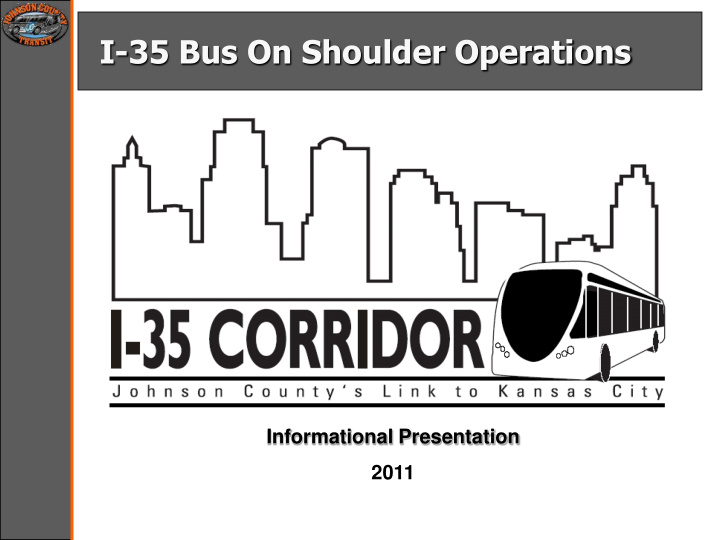



I-35 Bus On Shoulder Operations Informational Presentation 2011
Background I-35 is a main regional artery servicing the area. Recent studies show traffic volumes increasing on I-35 and it is approaching capacity. Recent studies show I-35 is a viable transit corridor for the region. Johnson County Transit is improving service along I-35 with additional and enhanced stops. There are additional opportunities to enhance transit in this area. Widening I-35 difficult because ROW needs and cost.
Innovation Bus On Shoulder (BOS) is an innovative way to move more people on existing I-35. Used in many other urban areas such as Minneapolis, Miami/Dade County, Chicago, Washington DC Bus On Shoulder moves more people efficiently using existing infrastructure Legislative Approval for Johnson County (Wyandotte County pending) Provides enhanced transportation options Improves air quality Reliable and efficient because buses run on schedule regardless of congestion
Numbers to Know A few dates and numbers to know: Service will start January 3nd, 2012. 8-10 buses a day will have the potential to use the shoulders. Training for drivers will be during the day (10 am to 1 pm) starting in late October running through November. Media announcing upcoming service will start in October.
Traffic Analysis Existing and future traffic analyzed in cooperation with KDOT Service vs. system interchange operations BOS has no negative effect on existing traffic VISSIM model Benefits Time savings on "normal" days (3-5 minutes) Greater opportunity for travel time savings when there are incidents or inclement weather
Operational Guidelines Uses shoulders during peak periods when traffic is moving slower than 35 mph. Buses using shoulders do not travel more than 35 mph. Buses do not travel more than 10 mph above traffic. Buses must yield to any vehicle entering, merging or exiting through the shoulder. Buses must re-enter the mainline where the shoulder is obstructed (vehicle debris, incident, etc).
Stop locations
Stop Design
Where will Bus on Shoulder be implemented?
Traffic — how it works mergetomainline.m pg stalled car.m pg transitionthroughgore.mpg
Safety Bus drivers are trained professional drivers Accountable to the operating rules Able to handle more complex driving decisions (On shoulder training to start late October) Buses are easily seen by other motorists Shoulder use is limited to a small number of vehicles Speeds are low
Safety Crash rates are extremely low for Bus on Shoulder Miami-Dade : “no incidents or accidents due to the Bus -on- Shoulders operation,” Miami Dade MPO, Bus On Shoulders Service Evaluation Minneapolis : “Mn/DOT performed an accident study that found that between 1991 and 2001 there were only 20 accidents on the shoulder involving a bus and all of these crashes caused property damage only. Most accidents consist of minor scrapes or mirror clips,” Bus-Only Shoulders in the Twin Cities Report San Diego : “no accidents have occurred as a result of the demonstration project,” Freeway Transit Lane Demonstration Project Status Report
Safety - Public Education Objective and Goals: Educate public about BoS operations and benefits. Key Audiences: highway users, commuters, bus users, community leaders, law enforcement, special interest groups. Media campaign starting: 10/2011
Enforcement Issues Potential copy cat drivers Jealous motorists Timely removal of vehicles left on shoulder Incident management Bus driver violations
Maintenance Issues Snow removal Debris removal Storm drain Pavement markings
Timeline Service will start January 3rd, 2012 Construction to the shoulders, guard rails, signage, markings began October 14th Station letting in Spring 2012 Training on the shoulders for drivers will be during the day (10 am to 1 pm) late October/early November Media announcing upcoming service will occur as changes become noticeable — construction announcement, signage goes up, as training begins - October
I-35 Bus on Shoulder Questions & Comments
Recommend
More recommend